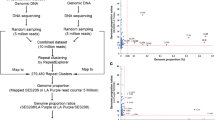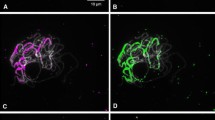Abstract
Species-specific repetitive DNA probes are a useful tool for the molecular identification of somatic hybrids. Therefore, the distribution of three repetitive DNA elements of Solanum was investigated in Solanum wild species, Solanum breeding lines, and in more distantly related species of the genera Lycopersicon, Nicotiana, and Datura. The clone pSCH15, obtained from S. circaeifolium, represents a new 168-bp repetitive element; it shows 73–79% sequence similarity to repetitive elements of S. brevidens and Lycopersicon species. The 163-bp element in pSBH6, cloned from S. bulbocastanum, turned out to be very similar (95% sequence homology) to the Lycopersicon element pLEG15/TGRI previously regarded to be present only in species of the genus Lycopersicon and in S. lycopersicoides. Lower sequence similarity of approximately 80% was observed to repetitive elements of S. brevidens which are organized differently. The repeats exhibited different degrees of specificity: by Southern hybridization the element represented by the clone pSBH6 could be detected in almost all Solanum species investigated here but only after long exposure to X-ray film. The previously described “Solanum-specific” element represented by the clone pSA287 was also found, although in a very low copy number, in Lycopersicon esculentum. Therefore, detection of the repetitive elements pSA287 and pSBH6 in those species in which the respective repeat is less represented depends on exposure time. In contrast, the element pSCH15 is prominently present only in a small number of Solanum wild species and — to some extent — in the diploid breeding lines as revealed after long exposure. Use of these repeated elements for the identification of specific genomes in protoplast-fusion hybrids between Solanum wild species and Solanum breeding lines, or between two breeding lines, was evaluated.
Similar content being viewed by others
References
Borisjuk N, Borisjuk L, Petjuch G, Hemleben V (1994) Comparison of nuclear ribosomal RNA genes among Solanum species and other Solanaceae. Genome 37:271–279
Flavell RB (1986) Repetitive DNA and chromosome evolution in plants. Phil Trans R Soc Lond. B312:227–242
Ganal MW, Lapitan NI, Tanksley SD (1988) A molecular and cytogenetic survey of major repeated DNA sequences in tomato (Lycopersicon esculentum). Mol Gen Genet 213:262–268
Gebhardt C, Ritter E, Debener T, Schachtschabel U, Walkemeier B, Uhrig H, Salamini F (1989) RFLP analysis and linkage mapping in Solanum tuberosum. Theor Appl Genet 78:65–75
Gebhardt C, Eberle B, Leonards-Schippers C, Walkemeier B, Salamini F (1995) Isolation, characterization and RFLP linkage mapping of a DNA repeat family of Solanum spegazzinii by which chromosome ends can be localized on the genetic map of potato. Genet Res 65:1–10
Hawkes J (1990) The potato evolution, biodiversity and genetic resources. Smithonian Institution Press, Washington
Hemleben V (1993) Repetitive and highly repetitive DNA components as molecular markers for evolutionary studies and in plant breeding. Curr Top Mol Genet (Life Sci Adv) 1:173–185
Hemleben V, Zentgraf U, King K, Borisjuk N, Schweizer G (1992) Middle repetitive and highly repetitive sequences detect polymorphisms in plants. In: Kahl G, Appelhans H, Kömpf J, Driesel AJ (eds) DNA polymorphism in eucaryotic genomes. Huethig, Heidelberg (BTF 10, Adv Mol Genet 5:157–170)
Keller WA, Melchers G (1973) The effect of high pH and calcium on tobacco leaf protoplast fusion. Z Naturforsch 28c:737–741
King K, Jobst J, Hemleben V (1995) Differential homogenization and amplification of two satellite DNAs in the genus Cucurbita (Cucurbitaceae) J Mol Evol (in press)
Koulakova B, Reich J, Matyasek R, Kuhrova V, Bezdek M (1989) A BamHI family of repeated DNA sequences of Nicotiana tabacum. Theor Appl Genet 78:77–80
Lapitan NLV (1992) Organization and evolution of higher plant nuclear genomes. Genome 35:171–181
Lapitan NLV, Ganal MW, Tanksley SD (1989) Somatic chromosome karyotype of tomato based on in situ hybridization of the TGRI satellite repeat. Genome 32:992–998
Maniatis T, Fritsch E, Sambrock J (1982) Molecular cloning. Cold Spring Harbour Laboratory, Cold Spring Harbor, New York
Melchers G, Labib G (1974) Somatic hybridization of plants by fusion of protoplasts. I. Selection of light-resistant hybrids of “haploid” light-sensitive varieties of tobacco. Mol Gen Genet 135:277–294
Murashige T, Skoog F (1962) A revised medium for rapid growth and bioassays with tissue cultures. Physiol Plant 15:473–497
Myers EW, Miller W (1988) Optimal alignment in linear space. CABIOS 4:11–17
Novy RG, Helgeson JP (1994) Somatic hybrids between Solanum etuberosum and diploid, tuber-bearing Solanum clones. Theor Appl Genet 89:775–782
Pehu E, Thomas M, Poutala T, Karp A, Jones MGK (1990) Species-specific sequences in the genus Solanum: identification, characterization and application to study somatic hybrids of S. brevidens and S. tuberosum.Theor Appl Genet 80:693–698
Preizsner J, Tacács I, Bilgin M, Györgyey J, Dudits D, Fehér A (1994) Organization of a Solanum brevidens repetitive sequence related to the TGRI subtelomeric repeats of Lycopersicon esculentum. Theor Appl Genet 89:1–8
Ross H (1986) Advances in plant breeding: potato breeding — problems and perspectives, Parey, Berlin, Hamburg
Schilde-Rentschler L, Doos G, Ninnemann H (1987) Somatic hybridization of dihaploid potato breeding lines, a tool in potato breeding. In Puite KJ, Dons JJM, Huizing HJ, Kool AJ, Korneef M, Krens FA (eds) Current plant science and biotechnology in agriculture progress in protoplast research. Kluwer Academic Publishers, Dordrecht Boston London, pp 195–196
Schilde-Rentschler L, Ruoss B, Schierbaum B, Ninnemann H (1993) Availability of new genetic resources from wild species for potato breeding. EAPR Abstracts: 99–100
Schweizer G, Hemleben V (1988) Charakterisierung spezifischer repetitiver Genomkomponenten in Kartoffelsorten, Wildarten und deren somatischen Hybridpflanzen. In: Beschleunigung der Züchtung durch Zellkultur und Zellfusion; Vortr Pflanzen-züchtung 14:165–175
Schweizer G, Ganal M, Ninnemann H, Hemleben V (1988) Species-specific DNA sequences for the identification of somatic hybrids between Lycopersicon esculentum and Solanum acaule. Theor Appl Genet 75:679–684
Schweizer G, Borisjuk N, Borisjuk L, Stadler M, Stelzer T, Schilde-Rentschler L, Hemleben V (1993) Organization and distribution of different repeated genome elements in Solanum and their use as markers for the characterization of species and cultivars. Theor Appl Genet 85:801–808
Stelzer T, Stadler M, Zanke C, Ruoss B, Schilde-Rentschler L, Ninnemann H, Hemleben V (1994) Molekulare Analyse von symmetrisch somatischen Fusionshybriden aus Zuchtlinien oder Zuchtlinien und Wildarten (S. bulbocastanum und S. pinnatisectum) der Kartoffel. Vortr Pflanzenzüchtung 28:217–219
Wenzel G, Schieder O, Przewozny T, Sopory S, Melchers G (1979) Comparison of single cell culture-derived Solanum tuberosum L. plants and a model for their application in breeding programs. Theor Appl Genet 55: 49–55
Wu T, Wu R (1992) A novel DNA sequence in the genus Oryza. Theor Appl Genet 84:136–144
Yanisch-Perron C, Vieira J, Messing J (1985) Improved M13 phage cloning vectors and host strains: nucleotide sequences of the M13 mp18 and pUC 19 vectors. Gene 33:103–119
Zanke C, Borisjuk N, Ruoss B, Schilde-Rentschler L, Ninnemann H, Hemleben V (1995) A specific oligonucleotide of the 5S rDNA spacer and species-specific elements identify symmetric somatic hybrids between Solanum tuberosum and S. pinnatisectum. Theor Appl Genet 90:720–726
Author information
Authors and Affiliations
Additional information
Communicated by G. Wenzel
Rights and permissions
About this article
Cite this article
Stadler, M., Stelzer, T., Borisjuk, N. et al. Distribution of novel and known repeated elements of Solanum and application for the identification of somatic hybrids among Solanum species. Theoret. Appl. Genetics 91, 1271–1278 (1995). https://doi.org/10.1007/BF00220940
Received:
Accepted:
Issue Date:
DOI: https://doi.org/10.1007/BF00220940




